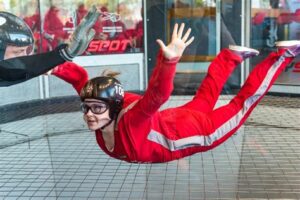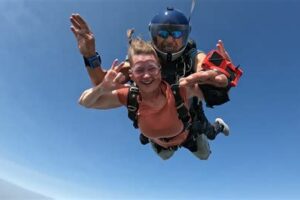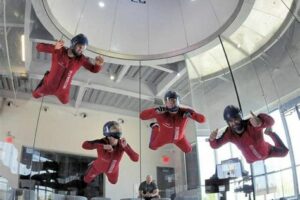Table of Contents
Looking for indoor skydiving instructions? Discover the ultimate guide to indoor skydiving techniques and safety tips. Learn how to perfect your body position, control your movements, and experience the thrill of freefall in a controlled environment. Get ready to defy gravity and embark on an exhilarating adventure!
Are you ready to experience the thrill of skydiving without jumping out of a plane? Look no further than indoor skydiving! Indoor skydiving is a unique and exhilarating activity that simulates the freefall sensation of skydiving in a safe and controlled environment. Whether you’re a first-timer or a seasoned thrill-seeker, mastering the art of indoor skydiving requires careful instruction and practice. In this guide, we will take you through the essential steps and techniques to ensure you have a safe and unforgettable indoor skydiving experience. So, fasten your seatbelts (or rather, your flight suit) and get ready to soar through the air like a pro!
Introduction
Indoor skydiving, also known as bodyflight or indoor tunnel flying, is a thrilling sport that simulates the sensation of freefall without the need for an airplane. It offers an exciting alternative for those who want to experience the adrenaline rush of skydiving but in a controlled environment. Whether you are a beginner or an experienced skydiver looking to refine your skills, this article will provide you with step-by-step instructions on how to enjoy the exhilarating adventure of indoor skydiving.
Gearing Up
Before you enter the wind tunnel, it’s essential to put on the appropriate gear. The standard equipment includes a jumpsuit, helmet, goggles, and earplugs. The jumpsuit helps streamline your body and protect your clothing from wind friction, while the helmet and goggles ensure your safety by shielding your head and eyes from any potential hazards. Lastly, earplugs are necessary to reduce noise levels in the tunnel.
Body Positioning
In indoor skydiving, maintaining the correct body position is crucial for stability and control. The ideal posture involves arching your back, keeping your legs straight, and bending your arms slightly at the elbows. By arching your back, you create a surface area that allows air to flow evenly over your body, providing stability and lift. It’s important to practice and refine this position to enhance your flight experience.
Entering the Wind Tunnel
Once you’re suited up and ready, it’s time to enter the wind tunnel. Approach the tunnel cautiously, as the wind speed can be quite strong. Listen carefully to your instructor’s guidance on how to position yourself at the tunnel’s entrance. Most often, you’ll need to lean forward slightly while keeping your body tight and compact to smoothly enter the wind tunnel.
Controlling Your Movements
As you enter the wind tunnel, you’ll feel the powerful force of the wind beneath you, simulating the sensation of freefall. To control your movements, focus on small adjustments rather than big, exaggerated motions. Shift your body weight slightly to the left or right to change direction, and straighten or bend your legs to ascend or descend. Keep your movements precise and controlled to maintain stability.
Communication Signals
During your indoor skydiving session, effective communication with your instructor is essential. Since it can be challenging to hear each other due to wind noise, hand signals are commonly used. These signals typically include signs for stop, relax, bend legs, and straighten legs. Familiarize yourself with these signals before your flight to ensure clear communication and a safe experience.
Enhancing Maneuverability
Once you have mastered the basics, you can start exploring more advanced maneuvers. These include spins, flips, and turns that allow you to experience the thrill of aerial acrobatics. However, it’s crucial to remember that these maneuvers require practice, skill, and proper instruction. Always consult with experienced instructors to learn new techniques and ensure your safety.
Building Confidence
Like any sport or activity, confidence plays a vital role in indoor skydiving. Initially, the wind tunnel’s force may feel overwhelming, but as you become more comfortable with the sensation, your confidence will grow. Trust in your body positioning and movements, and maintain a positive mindset. With practice and persistence, you’ll develop the skills needed to enjoy a seamless and exhilarating flight experience.
Post-Flight Analysis
After each session, take the time to review and reflect on your performance. Discuss your flight with the instructor, who can provide valuable feedback and advice for improvement. Analyzing your body position, movements, and overall technique will help you identify areas that need refinement. Embrace constructive criticism and use it as an opportunity to enhance your skills and become a more proficient indoor skydiver.
Expanding Your Horizons
If you find yourself captivated by the world of indoor skydiving, consider taking your skills to the next level by participating in competitions or joining a skydiving team. These opportunities allow you to showcase your talent, connect with fellow enthusiasts, and challenge yourself further. Always remember to prioritize safety and continue learning from experienced professionals as you explore the limitless possibilities of indoor skydiving.
Conclusion
Indoor skydiving offers a thrilling adventure for individuals of all skill levels. By following these instructions and practicing regularly, you can master the art of bodyflight while enjoying the exhilarating sensation of freefall. Remember to prioritize safety, listen to your instructors, and embrace the learning process. Whether you choose to pursue indoor skydiving as a recreational hobby or a competitive endeavor, this sport promises endless excitement and an unforgettable experience.
Indoor Skydiving Instructions: Mastering the Art of Indoor Flight
Indoor skydiving is an exhilarating experience that allows individuals to defy gravity and experience the thrill of freefall in a controlled environment. To ensure a safe and enjoyable flight, it is crucial to follow these indoor skydiving instructions and master the art of indoor flight.
1. Proper Attire: Dress for Success
Before entering the vertical wind tunnel, it is essential to wear the appropriate attire. Opt for comfortable athletic wear made of non-restrictive materials. Loose articles of clothing should be avoided as they may be blown away during the flight. Additionally, secure your hair, remove jewelry, and wear closed-toe shoes to ensure safety and prevent any distractions during the experience.
2. Pre-Flight Briefing: Knowledge is Power
Prior to entering the wind tunnel, listen attentively to the experienced instructor during the pre-flight briefing. They will provide comprehensive information on proper body positioning, hand signals, and safety protocols. Paying close attention to these instructions will ensure a successful flight and maximize your enjoyment.
3. Entering the Wind Tunnel: Step into the Void
When stepping inside the wind tunnel, it is important to maintain a strong and stable posture. The powerful wind generated by the tunnel will support your body, allowing you to fly effortlessly. Keep your body straight and upright, allowing the airflow to lift you off the ground and into the thrilling world of indoor skydiving.
4. Body Positioning: Perfect the Posture
Achieving the correct body position is crucial for stability in the wind tunnel. Adopt the banana shape – arch your back, lift your chest, and slightly bend your knees. Engaging your core muscles will help maintain stability, while keeping your chin up promotes proper airflow. Remember to always relax and avoid unnecessary tension.
5. Stability and Balance: Establishing Control
Maintaining stability and balance is essential for a successful indoor skydiving experience. Focus on evenly distributing your body weight and adjust your limbs accordingly to fine-tune your control. Stable arm and leg movements, along with subtle shifts in your body position, will enable you to maintain equilibrium during the exhilarating flight.
6. Communication: Master the Hand Signals
Clear communication with your instructor is crucial in the wind tunnel. Learn and practice the necessary hand signals beforehand to enhance safety and improve the overall cohesiveness of the experience. Familiarize yourself with signals for stop, relax, straighten legs, bend knees, and other essential commands to facilitate effective communication during flight.
7. Flying Techniques: Soar with Expertise
Once you have achieved basic stability, you can start exploring various flying techniques in the wind tunnel. Under the guidance of your instructor, experiment with turns, spins, and flips. These maneuvers will enhance your flight experience and allow you to experience the thrill of maneuvers typically reserved for freefall skydiving.
8. Post-Flight Analysis: Reflect and Improve
After your flight, take the time to discuss your experience with your instructor. They will provide valuable feedback to help you enhance your body positioning, maneuvering skills, and overall technique. Reflecting on your performance and applying the instructor’s suggestions will enable you to progress and excel in the thrilling world of indoor skydiving.
Mastering the art of indoor flight requires attentiveness, practice, and a willingness to push your boundaries. By following these indoor skydiving instructions and embracing the guidance of experienced instructors, you can unlock the exhilaration of defying gravity and soar to new heights in the vertical wind tunnel.
Indoor Skydiving Instructions: A Professional Guide
When it comes to experiencing the thrill of skydiving without the risks of jumping out of a plane, indoor skydiving provides an exhilarating alternative. To ensure a safe and enjoyable experience, it is crucial to follow the instructions provided by trained professionals. Here are some key points to keep in mind:
- Listen attentively: Pay close attention to the instructions given by your instructor. They possess the knowledge and expertise necessary to guide you through the process safely.
- Dress appropriately: Wear comfortable clothing that allows freedom of movement. Avoid loose items such as scarves or jewelry that could become tangled during the activity.
- Warm-up exercises: Engage in warm-up exercises recommended by the instructor. These exercises will help loosen up your muscles and prepare your body for the experience.
- Body positioning: Maintain the correct body posture during the flight. Keep your chin up, arms slightly bent, and legs slightly apart. This position ensures stability and control while in the wind tunnel.
- Breathing techniques: Focus on your breathing. Inhale deeply through your nose and exhale through your mouth. Controlled breathing helps maintain stability and balance.
- Communication signals: Learn and understand the hand signals used for communication inside the wind tunnel. Clear communication between you and the instructor is essential for a safe and enjoyable experience.
- Avoid sudden movements: Make smooth and controlled movements while flying. Sudden jerks or flailing limbs can disrupt your balance and potentially cause injury.
- Stay relaxed: Maintain a relaxed and calm demeanor throughout the experience. Tension or panic can hinder your ability to control your body and enjoy the flight.
- Follow safety guidelines: Adhere to all safety guidelines provided by the instructor. These guidelines are designed to protect your well-being and ensure a positive experience for everyone involved.
- Ask questions: If you are unsure about any aspect of the instructions or techniques, do not hesitate to ask your instructor for clarification. They are there to help and guide you.
By following these instructions, you can make the most out of your indoor skydiving experience while ensuring your safety and that of others. Remember, indoor skydiving is an exhilarating adventure that requires focus, discipline, and adherence to professional guidance. So, embrace the thrill, savor the moment, and enjoy the unforgettable sensation of defying gravity in a controlled environment!
Thank you for visiting our blog and taking the time to learn about indoor skydiving instructions. We hope that you found the information provided helpful and informative. As professionals in the field, we are passionate about sharing our knowledge and experiences with others who are interested in this exhilarating sport.
Indoor skydiving is a thrilling activity that allows individuals to experience the sensation of freefalling in a controlled environment. Whether you are a beginner or an experienced skydiver, it is important to understand and follow proper instructions to ensure a safe and enjoyable experience. In this blog, we have outlined some essential guidelines to help you get started on your indoor skydiving journey.
First and foremost, it is crucial to listen carefully to the instructions provided by your instructor. They are trained professionals who will guide you through the entire process, from gearing up to executing different maneuvers in the wind tunnel. Pay attention to their guidance on body positioning, hand signals, and breathing techniques. These instructions are designed to help you maintain stability and control during your flight.
Furthermore, it is important to dress appropriately for indoor skydiving. Wear comfortable clothing that allows for freedom of movement. Avoid wearing loose jewelry or accessories that could become entangled in the wind tunnel. Most importantly, make sure to wear the safety gear provided, including a jumpsuit, helmet, and goggles. Safety should always be a top priority, and these precautions are in place to protect you during your flight.
In addition to following instructions and dressing appropriately, it is essential to maintain a positive mindset. Indoor skydiving can be a bit overwhelming for beginners, but remember that it is a learning process. Be patient with yourself and trust in the skills and expertise of your instructor. With practice, you will become more comfortable and confident in the wind tunnel.
In conclusion, indoor skydiving is an incredible activity that offers the thrill of freefalling in a safe and controlled environment. By following proper instructions, dressing appropriately, and maintaining a positive mindset, you can have a truly unforgettable experience. Whether you are trying it for the first time or looking to improve your skills, we hope that our blog has provided you with valuable insights and tips. So go ahead, take the leap, and enjoy the incredible sensation of indoor skydiving!
Thank you again for visiting our blog, and we look forward to sharing more exciting content with you in the future. Safe flights!
Video Indoor Skydiving Instructions
Here are some common questions people also ask about indoor skydiving instructions:
-
What should I wear when indoor skydiving?
It is recommended to wear comfortable clothing such as a t-shirt, shorts or pants, and athletic shoes. Avoid wearing anything too loose or restrictive that may affect your movement during the experience.
-
Do I need previous skydiving experience?
No, you do not need any prior skydiving experience to participate in indoor skydiving. Indoor skydiving facilities provide all the necessary training and equipment for beginners.
-
How long does an indoor skydiving session last?
The duration of an indoor skydiving session varies depending on the package you choose. On average, a session can last between one to two minutes of actual flight time. However, the entire experience, including training and gearing up, may take around one to two hours.
-
Are there any age restrictions for indoor skydiving?
Most indoor skydiving facilities have minimum age requirements. The age limit can range from around 3 to 6 years old, depending on the location and the specific facility’s guidelines. It’s best to check with the facility beforehand to determine if there are any age restrictions.
-
Is indoor skydiving safe?
Indoor skydiving is generally considered a safe activity. The facilities prioritize safety and provide proper training to participants. They also have trained instructors who guide you throughout the experience. However, it is important to follow the instructions given by the staff and adhere to all safety guidelines to ensure a safe and enjoyable experience.
-
Can I bring my own equipment for indoor skydiving?
In most cases, you are not allowed to bring your own equipment for indoor skydiving. The facilities provide all the necessary gear, including the flight suit, helmet, goggles, and earplugs. This ensures that the equipment meets safety standards and is suitable for indoor skydiving.
Remember to check with the specific indoor skydiving facility you plan to visit for any additional instructions or requirements they may have.






